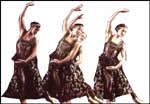
Any engagement of the Paul Taylor Dance Company – like the recent one at City Center – elicits gratitude for Taylor’s intelligence, wit, sophistication, musicality, psychological perception, and theatrical acumen. If that weren’t enough, one of this season’s novelties, Cascade, set to excerpts from Bach’s Concertos for Piano and Orchestra, looks like top-drawer Taylor, destined for a long life in the repertory.
As the choreographer has persistently been instructing his interviewers, the piece is an exercise in symmetry, an element he usually ignores in favor of off-kilter designs. The symmetry of the setups – a duet, for instance, executed simultaneously by two male-female pairs – is enlarged through the constant use of movement strategies such as repetition, refraction, and echoing. As the dance progresses, it persuades you that there are only half a dozen movement phrases in the universe and that Taylor has created a modulated, eloquent language with them.
Played suavely against formal structure in Cascade is a mood of dark tenderness that is extremely touching, occasionally heartbreaking. Generated in a duet for Maureen Mansfield and Patrick Corbin, it seems, in retrospect, to pervade the entire piece, offering the viewpoint of someone who knows that though love is futile, inevitably thwarted by dissension or death, it remains the only thing in life worth trying for. A gorgeous solo for Francie Huber lies at the center of the piece, proposing her as the spirit animating the imaginary world the choreographer has brought into being. Voluptuous and ecstatic, it incorporates motifs from Isadora Duncan and Doris Humphrey, as if Taylor, at his most fluent moments of invention, is listening to ancestral footsteps.
Arabesque, Taylor’s other new-to-New York offering, is one of his archaic Mediterranean dances. Set to chamber music by Debussy, it evokes a realm of nature in which myriad gods and goddesses are immanent. This is a primordial, amoral world where benign creatures co-exist with demonic ones. Taylor takes perverse pleasure here in letting the latter dominate. With her avid theatrical appetite and gypsy looks, Silvia Nevjinsky makes a terrific queen of this universe. She takes the ground into her confidence in a grand solo of enraged magical power, her body possessed by contrapuntal angles and curves. At the climax of her ritual, she freezes into an iconic posture that might transfix an archaeologist though it were no longer rendered in flesh but in stone.
As is reflected in the title – a reference to an elaborately twined design derived from Arab sources – the language of the piece centers on convoluted postures of eccentric elegance. These take on a bravura aspect when they’re assumed – and changed – with the dancers traveling at freeway speed. Though Taylor keeps Arabesque essentially abstract, he incorporates a single pantomimic incident: the lethal obscuring of vision. (Imagine the Dark Angel section of Balanchine’s Serenade followed by Oedipus’ final passage in Graham’s Night Journey.) Early in the piece, the Nevjinsky figure maims a male dancer in this way; the action is repeated, perpetrator and victim reversed, toward the end. The flaw in Arabesque is that only Taylor, apparently, knows what this is about.
As he approaches his 70th birthday and celebrates the 45th anniversary of his company, Taylor – like Merce Cunningham, the other great choreographer of his generation – is in a peculiar position. He has a roomful of formidable awards attesting to his indefatigable genius, among them America’s National Medal of Arts and the France’s order of the Legion of Honor. Yet he can’t pay the rent. The cost of his company’s studio is about to more than double, and a recent interview reported him openly worrying about this and hoping people would “help.” Because of budget constraints, his company has capitulated to the use of canned music, which does a serious disservice to both performers and audience. His valiant dancers make a living wage but hardly one commensurate with their prodigious talents and effort. At least half their remuneration remains intangible, lying in the privilege of being in Taylor’s orbit, the glory of animating his work. Taylor has always had a taste for the dark ironies of life, but I’ll bet he wouldn’t mind being spared our nation’s scorn in terms of practical support of the artists it claims to revere.